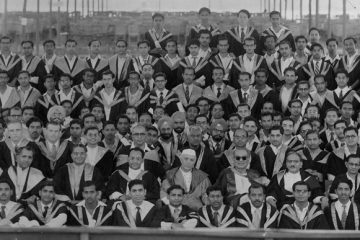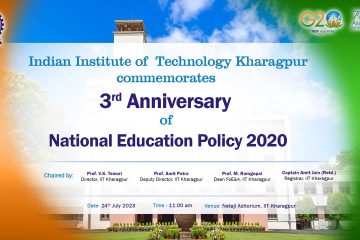 The Bio-Electrochemistry laboratory at IIT Kharagpur has helped IIT Kharagpur gain the fourth position among institutions in the world on the basis of its publication record on microbial fuel cell research for real field applications (according to Scopus database). The laboratory is the workplace and practically the home of Prof. Makarand Madhao Ghangrekar of the Department of Civil Engineering, who also heads the newly-established Aditya Choubey Center of Re-Water Research.
The Bio-Electrochemistry laboratory at IIT Kharagpur has helped IIT Kharagpur gain the fourth position among institutions in the world on the basis of its publication record on microbial fuel cell research for real field applications (according to Scopus database). The laboratory is the workplace and practically the home of Prof. Makarand Madhao Ghangrekar of the Department of Civil Engineering, who also heads the newly-established Aditya Choubey Center of Re-Water Research.
 In the last two years, Prof. Ghangrekar’s lab has published more than 50 journal papers in high impact factor journals such as Bioresource Technology, Electrochimica Acta, Bioelectrochemistry, International Journal of Hydrogen Energy and so on. The group’s 150 journal publications in reputed peer reviewed journals have received more than 3500 citations and command an h-index of 31 (Google Scholars). Students from universities in India and abroad (UC, Berkley; University of Bremen, Germany; Newcastle University, UK) have been visiting the laboratory to train in bio-electrochemistry research.
In the last two years, Prof. Ghangrekar’s lab has published more than 50 journal papers in high impact factor journals such as Bioresource Technology, Electrochimica Acta, Bioelectrochemistry, International Journal of Hydrogen Energy and so on. The group’s 150 journal publications in reputed peer reviewed journals have received more than 3500 citations and command an h-index of 31 (Google Scholars). Students from universities in India and abroad (UC, Berkley; University of Bremen, Germany; Newcastle University, UK) have been visiting the laboratory to train in bio-electrochemistry research.
The laboratory is mainly focused on various types of Bio-Electrochemical Systems (BESs) such as microbial fuel cell (MFC), microbial carbon capture, microbial electrosynthesis and so on. Prof. Ghangrekar says, “We mainly aim to fabricate low-cost BES and take this technology from lab-scale setup to successful field scale demonstration which should be both economically and environmentally sustainable.”
 BES is multidisciplinary approach for wastewater treatment and CO2 sequestration. These systems use microbes as biocatalyst for the production of value-added products like bioelectricity and organic chemicals during the treatment of waste water, thus eliminating the use of expensive metal based catalysts for these processes.
BES is multidisciplinary approach for wastewater treatment and CO2 sequestration. These systems use microbes as biocatalyst for the production of value-added products like bioelectricity and organic chemicals during the treatment of waste water, thus eliminating the use of expensive metal based catalysts for these processes.
The Bio-Electrochemistry lab at IIT Kharagpur has been focussing on various aspects of MFC (microbial fuel cell) to improve its performance both in term of power production and wastewater treatability. Various novel and low-cost electrocatalysts like CoZnFe, CuSn, Geothite, V2O5/Graphene oxide, Bi doped TiO2, WO3 etc. have been developed keeping in mind the field scale application of MFC.
A breakthrough has been the innovation of the proton exchange membrane (PEM) that separates the anodic and cathodic chamber in an MFC. Usually, the membrane is made of Nafion, which is extremely expensive, thereby raising the price of the MFC. But the Polyvinyl alcohol-Nafion-Borosilicate membrane invented by the research group is not only 11-fold cheaper but also more efficient in the treatment of distillery waste water. Extensive research has been undertaken to improve the electricity production of MFCs.
 Microbial carbon capture (MCC) is another application of BES where microalgae are used in the cathodic chamber for the sequestration of CO2 and production of organic chemicals. The microalgae can also be an excellent feedstock for biodiesel production on harvesting. Prof. Ghangrekar says, “We have tried to enhance and optimize the efficiency and cost associated with MCC.. Further, application of MCC in sediment remediation, desalination, urine treatment and acid alkali recovery was also examined.”
Microbial carbon capture (MCC) is another application of BES where microalgae are used in the cathodic chamber for the sequestration of CO2 and production of organic chemicals. The microalgae can also be an excellent feedstock for biodiesel production on harvesting. Prof. Ghangrekar says, “We have tried to enhance and optimize the efficiency and cost associated with MCC.. Further, application of MCC in sediment remediation, desalination, urine treatment and acid alkali recovery was also examined.”
Microbial electrosynthesis (MES) is a novel application of BESs that produces organic compounds by electrosynthesis through external application of electricity and the use of microorganisms as biocatalysts. Many organic compounds like acetate, butyrate, propionate, piperidinone etc. have been successfully synthesized in the lab through MES. “We are also exploring the possibility of synthesizing higher chain organic compounds using MES, which would increase the revenue generation from the process,” says Prof. Ghangrekar.
 Many of the technologies, such as the new PEM, are already in use in the 1500 litre MFC-based demonstration plant installed at IIT Kharagpur. This bio-toilet is the largest plant in the world for onsite treatment of sewage, electricity generation for illuminating toilets at night and producing recyclable quality treated water. A 750 litre MFC based demonstration plant has been installed by the team at NTPC, Noida. They are also working on multiple projects and collaborating with various international partners from Germany, Estonia, Belgium, and UK etc.
Many of the technologies, such as the new PEM, are already in use in the 1500 litre MFC-based demonstration plant installed at IIT Kharagpur. This bio-toilet is the largest plant in the world for onsite treatment of sewage, electricity generation for illuminating toilets at night and producing recyclable quality treated water. A 750 litre MFC based demonstration plant has been installed by the team at NTPC, Noida. They are also working on multiple projects and collaborating with various international partners from Germany, Estonia, Belgium, and UK etc.
I meet an upbeat team on my visit to the laboratory in the Civil Engineering Department. Neetu B., a senior member of the research team talks of Prof. Ghangrekar’s contribution to the success story. “Sir is motivating and at the same time very strict about the timely submission of papers.” Gourav Dhar Bhowmick chips in, “But he always encourages his team to get exposure to the renowned scientific community and gain the necessary confidence for innovative work.” A junior member of the team, Chabungbam Niranjit Khuman, talks about the ‘Chai-parties’ to celebrate the publication of each research article.
 Not surprisingly, Prof. Ghangrekar thanks his team in his Facebook post celebrating the lab’s success. “Credit goes to all the Research scholars working with me for their sincere effort and hard work. I know it is all the more challenging for them to manoeuvre this academic ladder with me maintaining the energy, pace, tenacity, at times patience, sustaining my anger, receiving no appreciation even for late night work and that too for 24X7 all the calendar days,” reads the post.
Not surprisingly, Prof. Ghangrekar thanks his team in his Facebook post celebrating the lab’s success. “Credit goes to all the Research scholars working with me for their sincere effort and hard work. I know it is all the more challenging for them to manoeuvre this academic ladder with me maintaining the energy, pace, tenacity, at times patience, sustaining my anger, receiving no appreciation even for late night work and that too for 24X7 all the calendar days,” reads the post.
Graphics : Suman Sutradhar



